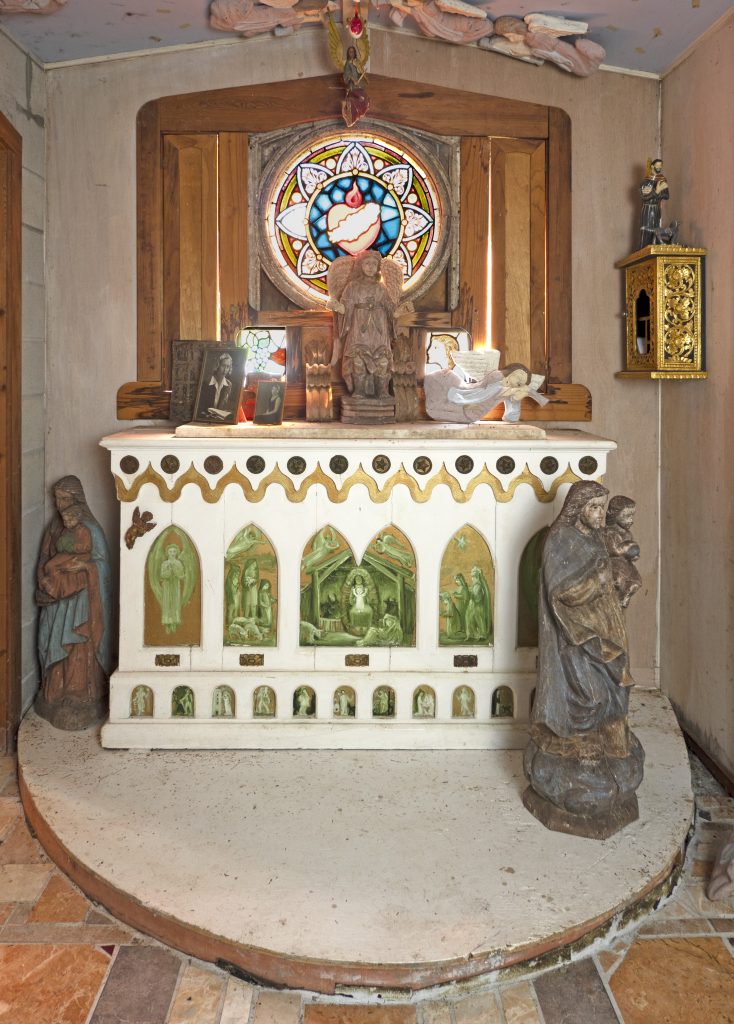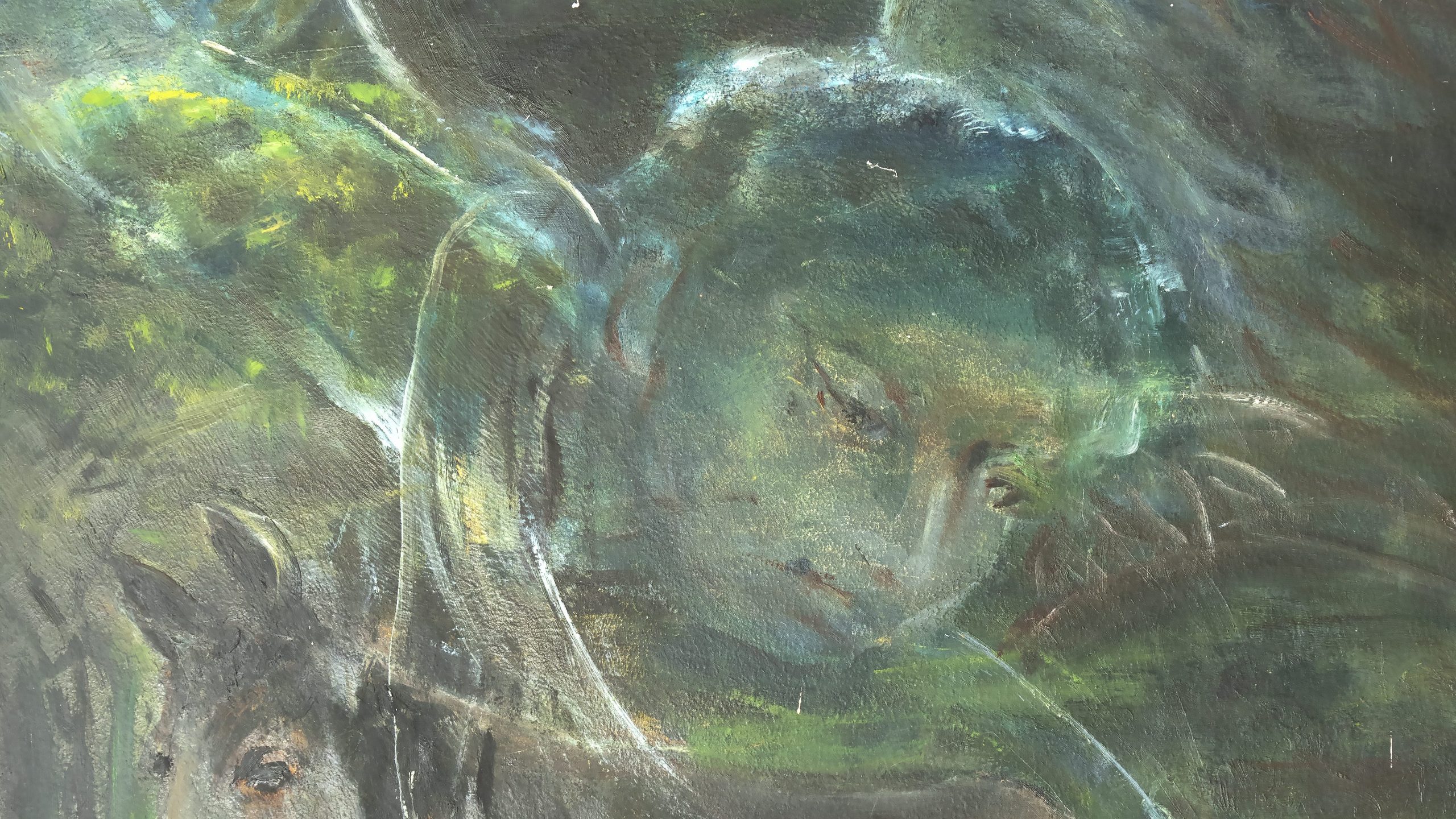Dedicated to the Holy Virgin


1. The Burning Heart Window
The stained-glass window (companion to the window in the main chapel) is from a burned-down church. The subject is the burning heart (of the Virgin, of Christ). It is an image of the “burning of the blood,” the universal experience of people in a spiritual ecstasy.
2. The Altar
The altar itself was found thrown out in Salinas. The center painting on the altar is the Nativity, with Joseph asleep. On the left are the three shepherds, and on the right the three kings. At the far left and right are angels.
At the foot of the altar are 18 miniature arched niches, 3 on the left side, 3 on the right, and 12 in the front. In them are painted images of saints taken from a pamphlet published by the Metropolitan Museum of Art in New York City describing the various saints depicted in paintings in the museum’s collection.

d. St. Frances de Sales, patron saint of gentlemen, with falcon and flowers
e. St. Anthony of Padua f. St. Barbara, with the tower
g. St. Christopher, carrying the Christ child
h. St. Margaret, with the dragon
i. St. Anthony, patron saint of domestic animals
j. St. Catherine of Antioch, patron saint of women scholars
l. St. Lucy, protector of sight, with eyes on the plate
m. St. Francis, with the wolf of Gubbio which he tamed
n. The Shower of Roses, from the Life of the Virgin
o. San Rocco, who fed people suffering from the plague and, when he got the plague himself, was fed by his dog
3. & 4. The Floor and Ceiling

The floor is of pieces of marble found at the dump. In the center is a labyrinth made by local artist, Coeleen Kiebert.
The ceiling is covered in paper mâché angels made in the Philippines. My nephew Jonathan came by one day with an angel he had bought at a store that was closing them out cheap. I said you go right back there and buy every one of them. And there they all are, like angels, abundant, free flying and floating.
The Virgin Paintings
Every society recognizes a holy virgin. The nature of nobility is that it doesn’t interact. (Gold is called a noble metal because it doesn’t interact.) Nobility (virginity) is a condition of isolation, separation. The noble virgin, the eternal virgin, is a new life with the potential to bear life but not yet entered into that condition. The conception of Christ by the Virgin is the great image of the interaction of spirit with the world. It is unique in her case, but partly experienced by every woman, and it educates all of us.
5. The Annunciation

As if the Virgin were a shepherdess, with a lamb and a dog. The dog is a puppy, starting back when confronted by the ewe (mother of the lamb the Virgin is holding) and by the angel. The painting depicts a sudden shift from the ordinary and extraordinary world of
nature, dog, sheep, water, etc., to the extraordinary world of Angel, prophecy, and descent of Christ (recalling the identification of Apollo with the Sun). It is also the first moment of a woman’s knowing she is going to have a child, the weight of the unknown future.
The left (the Angel) is all yang–gold, yellow, light. The right (the Virgin) is all yin–blue, water, darkness. Only through the combination of yang and yin, the union or invasion of opposites, can anything be created (green colors.)

6. The Visitation
The meeting of the Virgin and St. Elizabeth. St. John the Baptist in the womb leaps as he recognizes Christ in the womb of the Virgin. It is the first recognition, outside of the Virgin’s own, that this was the gift of God. The greatest mystery is reproduction, which is of ourselves but not ourselves. Two pregnant women meeting contain the future, but it is the unknown future. They are flanked by the torch (fire) bearer (to the left of the Virgin), and the water bearer (to the right of St. Elizabeth), both symbols of the spirit.


7. The Return from Egypt

Based on the traditional subject of the Flight into Egypt. Egypt is darkness, corrupted spirituality. Women are always tempted by it. That is, the corruption of the spiritual life tempts women especially. The exit from Egypt is the rejection of, and the departure from, the darkness: Exodus, rebirth, get out and stay out. In sleep Joseph is told by the angel that Herod is dead and it is safe to return. The Virgin and child are awake in their own world.

8. The Three Marys at the Tomb
Mary Magdalene says to the men (angels) “What have you done with the body of my Lord?” (John 20:13) The gospels differ about which women come to the tomb, but Mary Magdalene is always present (sometimes it is she and “some other women,” none identified in the gospels). Here it is the Virgin, Mary Magdalene, and Mary the mother of St. James. The loss to women because of a departure or a death or any loss is in a way greater than to men. The angels are unmoved by death, astounded by and mildly contemptuous of the density, solidity of human beings. Behind them, the darkness of the tomb, death, separation. The Virgin is not moved—turns away, as if to say “now it is accomplished.” She who was aware of the miraculousness of the birth is not surprised by the miracle of the resurrection.

